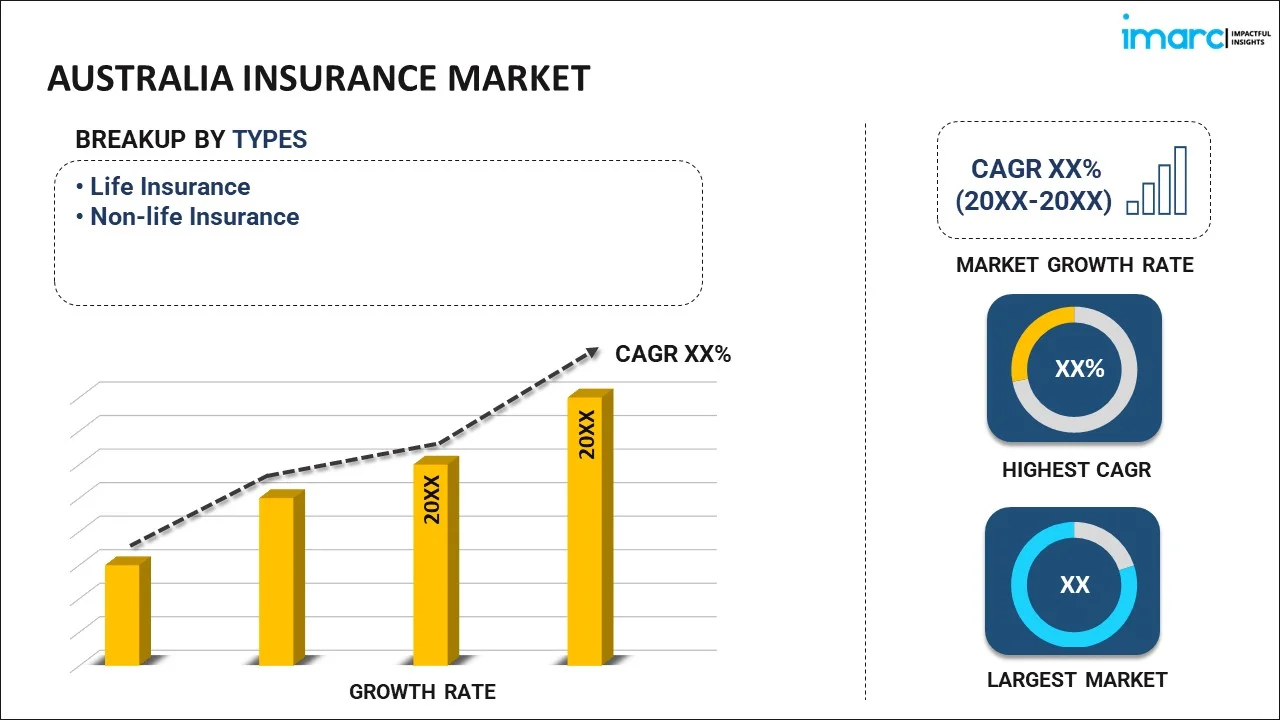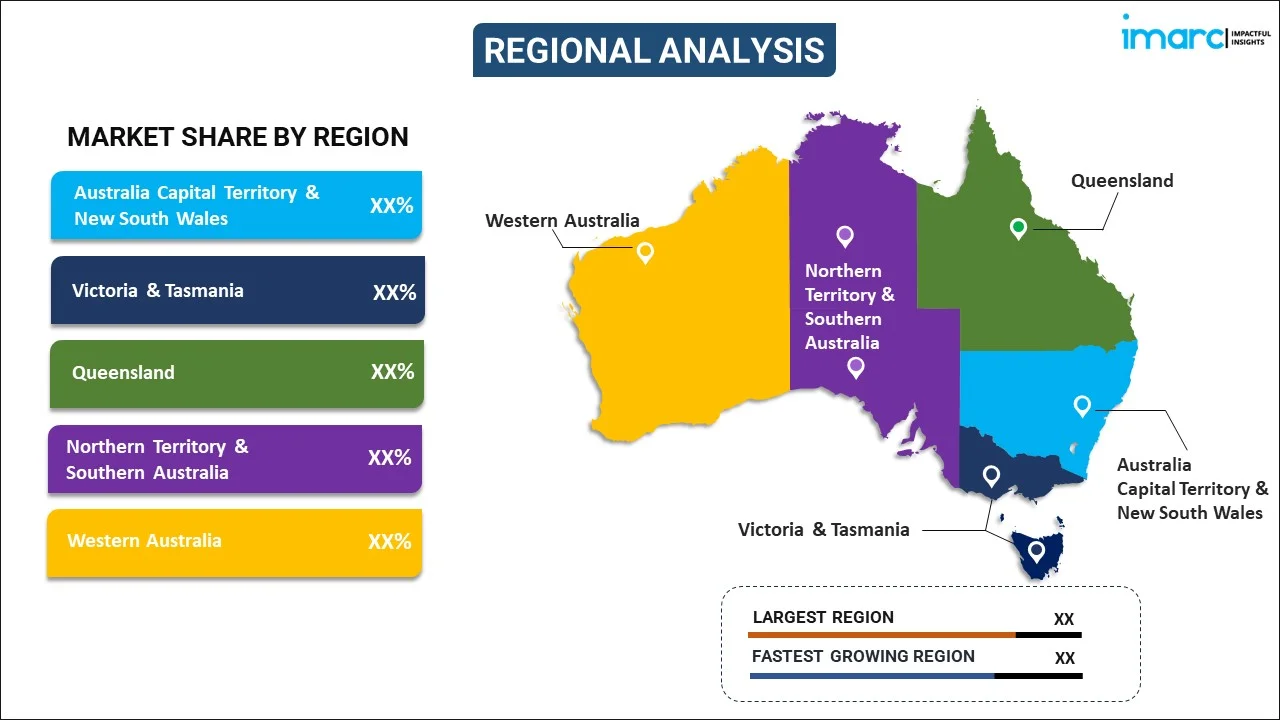
Australia Insurance Market Report by Type (Life Insurance, Non-life Insurance), and Region 2025-2033
Australia Insurance Market Size:
Australia insurance market size is projected to exhibit a growth rate (CAGR) of 2.95% during 2025-2033. The market in Australia is being driven by the increasing aging population, rapid technological advancements, rising health awareness among individuals, regulatory changes, the growing demand for cyber insurance, and the economic growth and inflating disposable incomes of individuals.
|
Report Attribute
|
Key Statistics
|
|---|---|
|
Base Year
|
2024 |
|
Forecast Years
|
2025-2033 |
|
Historical Years
|
2019-2024
|
| Market Growth Rate (2025-2033) | 2.95% |
Australia Insurance Market Analysis:
- Major Market Drivers: The Australia insurance market size is primarily driven by factors such as increasing awareness about risk management and insurance coverage, alongside regulatory reforms aimed at enhancing consumer protection and industry stability.
- Key Market Trends: Significant trends in the Australia insurance market include the rise of digital insurance platforms, personalized insurance products catering to niche markets, and the growing integration of artificial intelligence and data analytics for underwriting and claims processing efficiency.
- Competitive Landscape: Some of the major market players in the Australia insurance industry include
- Challenges and Opportunities: Challenges in the Australia insurance market share include navigating regulatory complexities, managing underwriting risks amidst changing climate patterns, and addressing cybersecurity threats. However, opportunities abound in expanding into emerging insurance segments such as cyber insurance, leveraging digital transformation for operational efficiency, and meeting the evolving needs of an aging population for retirement and health insurance solutions.
Australia Insurance Market Trends:
Rising disposable incomes of individuals
Rising disposable income is bolstering the insurance market as it increases individuals' capacity to afford and purchase various insurance products. When individuals possess greater financial resources, they frequently invest in comprehensive insurance coverage for their health, lives, properties, and other assets, such as vehicles. This approach aims to safeguard against damage or theft and ensure financial stability for both them and their descendants. Furthermore, rising disposable incomes mean that customers are able to go for increased policy limits and extra add-ons that increase the size of the industry overall. Such a change has helped insurers provide specific products that match the changing needs and abilities of well-off people which has consequently promoted growth and creativity in this field.
Increasing digital transformation
Another important driver of the Australia insurance market statistics is digital transformation. The adoption of digital technologies has enabled insurers to acquire more data on customer behavior and usage trends, allowing them to provide more tailored insurance products. Furthermore, digital technology has streamlined insurers' contact with customers. It enables them to deliver a more seamless experience. Customers can now access insurance products and services via digital channels such as mobile apps and websites, making it easier to manage their policies.
Emergence of Fintech
Fintech has had a positive impact on the insurance market by making it easier for providers to provide their products and for customers to buy and manage policies. Fintech has allowed insurance businesses to employ data analytics to better understand their consumers and provide personalized policies. This information can assist insurance companies in anticipating consumer wants and developing products that are suited to the customers' individual requirements, thereby creating a favorable Australia insurance market overview.
Australia Insurance Market Segmentation:
IMARC Group provides an analysis of the key trends in each segment of the market, along with forecasts at the country and regional levels for 2025-2033. Our report has categorized the market based on type.
Breakup by Type:

- Life Insurance
- Non-life Insurance
- Automobile Insurance
- Fire Insurance
- Liability Insurance
- Others
The report has provided a detailed breakup and analysis of the market based on the type. This includes life insurance and non-life insurance (automobile insurance, fire insurance, liability insurance, and others).
Breakup by Region:

- Australia Capital Territory & New South Wales
- Victoria & Tasmania
- Queensland
- Northern Territory & Southern Australia
- Western Australia
The report has also provided a comprehensive analysis of all the major markets in the region, which include Australia Capital Territory & New South Wales, Victoria & Tasmania, Queensland, Northern Territory & Southern Australia, and Western Australia.
Competitive Landscape:
- The market research report has also provided a comprehensive analysis of the competitive landscape in the market. Detailed profiles of all major companies have been provided.
- The market is characterized by a large number of regional players meeting the requirements of insurance. The key insurance companies are focusing on adopting various strategic initiatives, such as mergers and acquisitions, product launches, and partnerships to stay ahead of the competition and offer innovative solutions to their customers. As traditional insurers grapple with the challenges posed by shifting consumer preferences and technological advancements, insurance companies have capitalized on the opportunity to introduce innovative products and services that cater to the needs of their clientele. Artificial intelligence and machine learning help insurance companies to streamline underwriting and deliver more personalized coverage alternatives.
Australia Insurance Market Report Scope:
| Report Features | Details |
|---|---|
| Base Year of the Analysis | 2024 |
| Historical Period | 2019-2024 |
| Forecast Period | 2025-2033 |
| Units | Million USD |
| Scope of the Report | Exploration of Historical Trends and Market Outlook, Industry Catalysts and Challenges, Segment-Wise Historical and Future Market Assessment:
|
| Types Covered |
|
| Regions Covered | Australia Capital Territory & New South Wales, Victoria & Tasmania, Queensland, Northern Territory & Southern Australia, Western Australia |
| Customization Scope | 10% Free Customization |
| Post-Sale Analyst Support | 10-12 Weeks |
| Delivery Format | PDF and Excel through Email (We can also provide the editable version of the report in PPT/Word format on special request) |
Key Questions Answered in This Report:
- How has the Australia insurance market performed so far, and how will it perform in the coming years?
- What has been the impact of COVID-19 on the Australia insurance market?
- What is the breakup of the Australia insurance market on the basis of type?
- What are the various stages in the value chain of the Australia insurance market?
- What are the key driving factors and challenges in the Australia insurance market?
- What is the structure of the Australia insurance market, and who are the key players?
- What is the degree of competition in the Australia insurance market?
Key Benefits for Stakeholders:
- IMARC’s industry report offers a comprehensive quantitative analysis of various market segments, historical and current market trends, market forecasts, and dynamics of the Australia insurance market from 2019-2033.
- The research report provides the latest information on the market drivers, challenges, and opportunities in the Australia insurance market.
- Porter's five forces analysis assists stakeholders in assessing the impact of new entrants, competitive rivalry, supplier power, buyer power, and the threat of substitution. It helps stakeholders to analyze the level of competition within the Australia insurance industry and its attractiveness.
- The competitive landscape allows stakeholders to understand their competitive environment and provides an insight into the current positions of key players in the market.
Need more help?
- Speak to our experienced analysts for insights on the current market scenarios.
- Include additional segments and countries to customize the report as per your requirement.
- Gain an unparalleled competitive advantage in your domain by understanding how to utilize the report and positively impacting your operations and revenue.
- For further assistance, please connect with our analysts.
 Inquire Before Buying
Inquire Before Buying
 Speak to an Analyst
Speak to an Analyst
 Request Brochure
Request Brochure
 Request Customization
Request Customization




.webp)




.webp)












